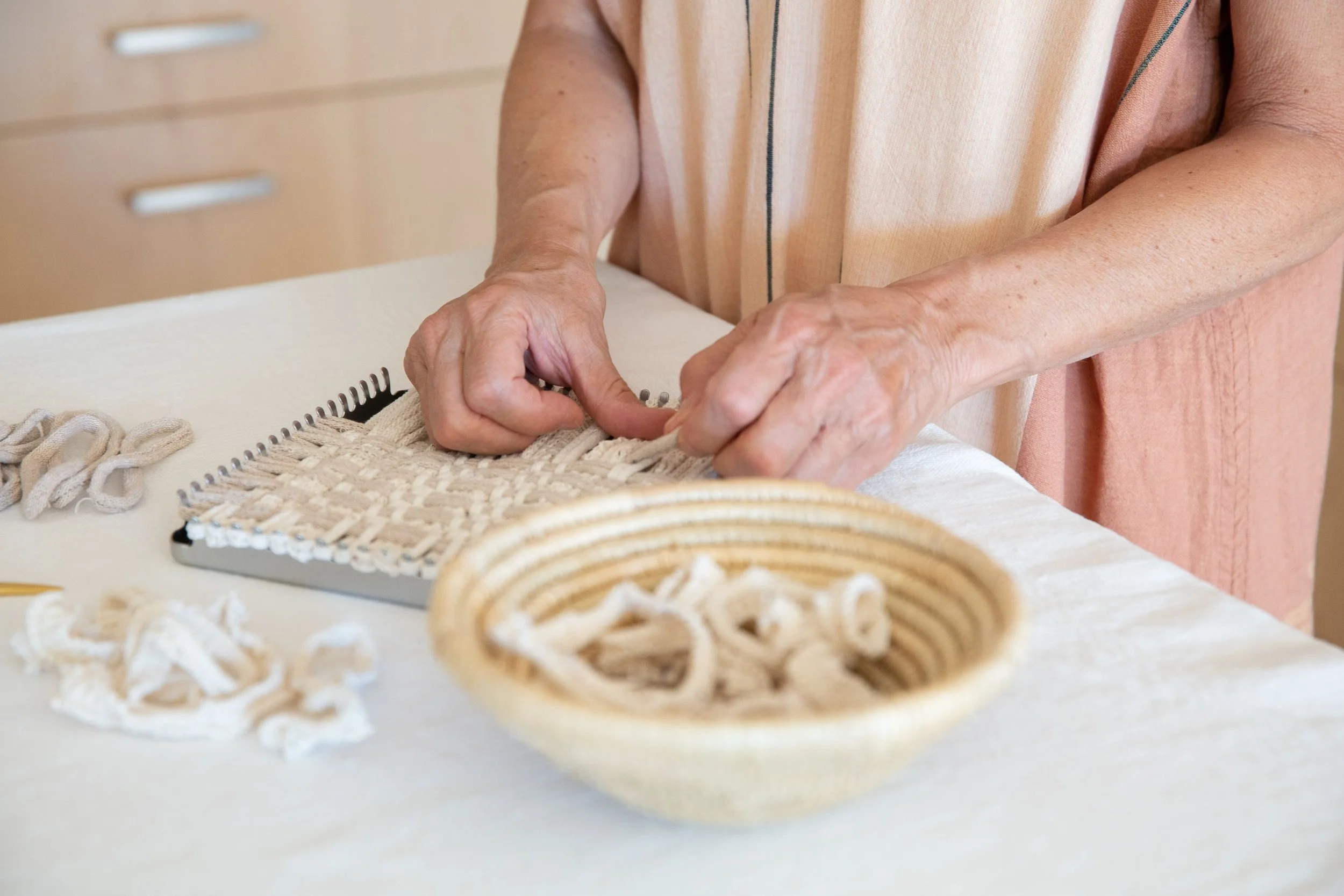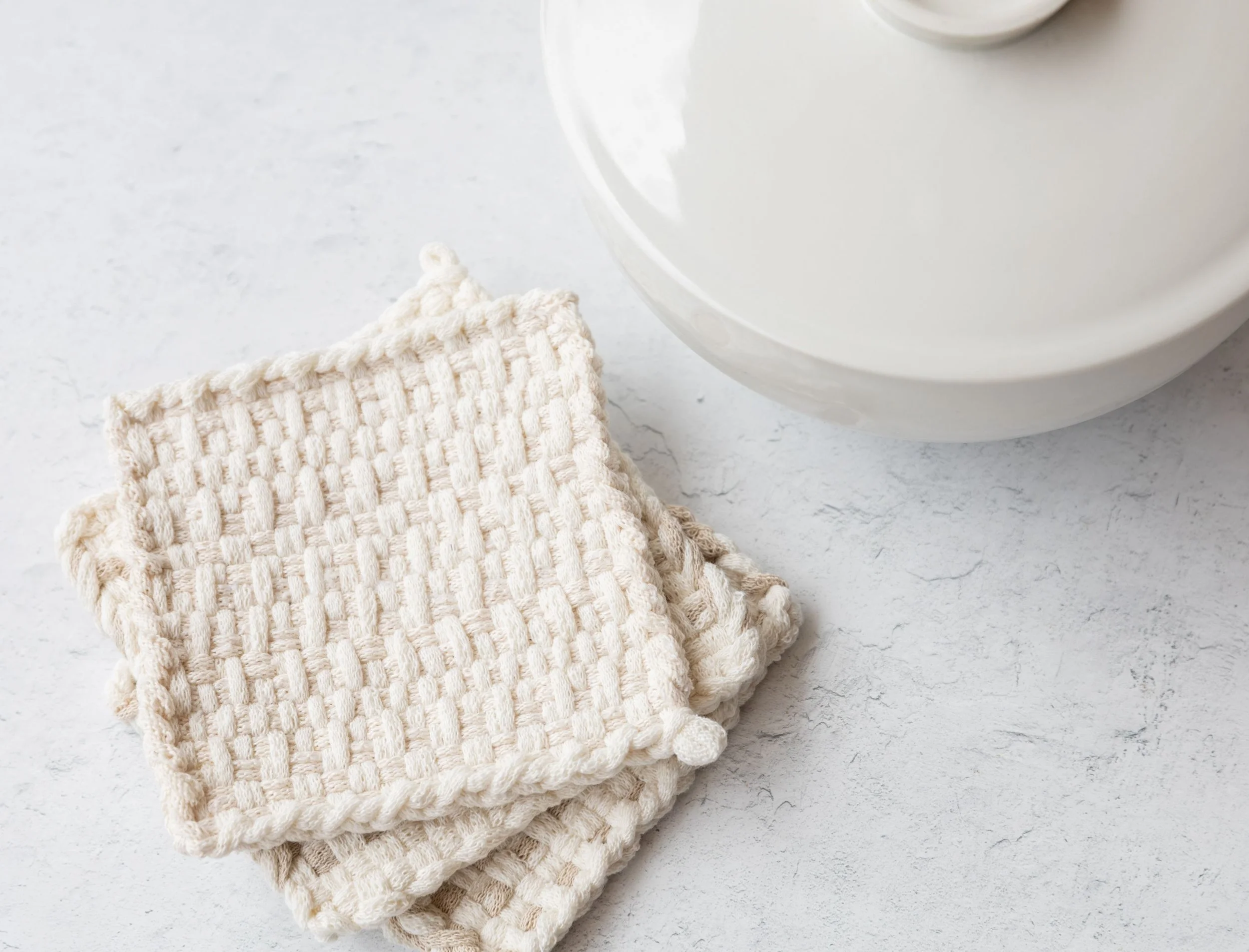Mindful Weaving with Kate Kilmurray
This month we are excited to highlight a very talented artist, Kate Kilmurray. Kate has been one of my photography clients for sometime now. Her presence is calm and her work is so fun to photograph. She is passionate about weaving and mindfulness and blends the two so perfectly. She has also just launched a new book, The Weaving Way - a journey of a handweaving community. The book brings together members of her Weaving Way Community, showcasing their workspaces, their weaving methods, where they seek their inspiration, what materials they use, how they weave and most importantly, why they weave.
As we step into a very busy holiday season I always think about how we can be mindful during this time and thought Kate was the perfect artist highlight for this month.
Can you share with us what initially drew you to the art of weaving, and how has your passion for this craft evolved over the years?
Several years ago, I unearthed a forgotten item from my childhood; a simple 7 x 7 inch metal handloom. Holding that loom, I remembered my grandmother’s hands teaching me to weave and realized that my introduction to meditation had happened in childhood, weaving on a handloom. When I rediscovered weaving, I remembered something that we, as a culture, find easy to forget; that we can always access inner stillness and peace through simple, embodied practices. My passion for handweaving has only grown since that moment and weaving is now intrinsic to my daily life and to my business.
Weaving is a traditional craft with a rich history. How do you balance honoring traditional techniques with incorporating your own modern and unique artistic voice?
One of the challenges that small-loom handweavers of my generation face is that our craft has been dismissed as purely an activity for children, or that the pieces we create aren't comparable to other forms of fiber work in terms of their sophistication. Handweaving methods are ancient and ancestral and when I weave, I feel aware that my hands move in the same way as generations of weavers before me, but I am also acutely aware that to ensure this art form is given the space and attention it deserves, it needs to have depth and presence for the 21st Century. Together with other handweavers, I work to pioneer new techniques, use sustainable materials and to develop patterns to reinvent handloom-woven work for the modern age, while remaining respectful to those who have gone before us.
Your art has a strong connection to mindfulness. How do you hope your audience experiences and interacts with your work, especially in a world that can be fast-paced and hectic?
Making beautiful handwoven textiles helps me to tap into my inner stillness and creativity, and I teach others to do the same via my workshops; to slow down, engage the rhythms of the body, and access a state of wholeness and flow. I offer a unique approach to developing a clear mind and an open heart through Weaving as Meditation and this is proving an ideal antidote to the hustle of our busy lives and a pause from cultural and societal pressures and traumas that we all live through.
Through my work, I’ve also recognized the importance of using craft to unite families through shared experience. I have a special handweaving kit for parents to help them to connect with their kids through an offline activity which can take place outside, and I have created a pattern book specifically for children to help them focus their mind, develop meaningful skills and relieve anxiety. In our social-media and gaming-obsessed world, handweaving has proven an adept tool to help children reconnect with their inner peace.
You recently published your new book ‘The Weaving Way - a journey of a handweaving community’ Could you share with us what we can find in your book and your inspiration on writing it?
The book is a celebration of the importance of handweaving in our society. Where women's stories in craft are often marginalized and undervalued, this book champions and centers them; showcasing the weavers' workspaces, weaving methods, where they seek inspiration, what materials they use, how they weave and most importantly, why they weave. It contains over 70 color pictures, highlighting the variety and depth of our fiber art, as well as personal essays helping the reader to understand how handweaving can help us navigate life-altering moments, including grief, retirement, education and health issues, as well as reflecting our everyday life.
I was inspired to curate this book by seeing the incredible work being shared and created by members of my Weaving Way Community. I wanted to uplift and champion our journeys in this craft and help to put handweaving on the map as a serious art form. The feedback I've received from readers has been truly incredible and the first print run of the book sold out in under a week. It is humbling to know that I am not alone and that by reading the book, other fiber enthusiasts are helping to make sure these stories are told.
Collaborating with other weavers for your recent book sounds like a unique experience. Can you tell us about the collaborative process and how working with others influenced your creative approach?
It has been amazing to see how each contributor to the book produced such varied words and images to represent their stories, even though all of them were sent the same brief and set of questions to help move them to begin writing and creating. I knew I wanted to hear about the weaver's inspiration, the environment in which they weave and crucially why they weave, but I think the experience really helped the contributors to delve into how weaving can be a physical manifestation of deeper emotions and life-altering experiences. The book features stories of grief, poetry, even how weaving helped one contributor to stay calm in a storm at sea. Even though this was a book about a visual art form. The words were important, as important as the imagery and I worked closely with a designer to ensure that the page layouts helped to give attention and solemnity to both.
Can you share some advice for aspiring weavers or artists who are interested in exploring the meditative aspects of weaving? What lessons or insights would you offer based on your own journey in the craft?
Having a daily meditation practice is essential. Our nervous system needs to have time to rest from the overstimulation and stress of the world. Practicing for just 10 minutes a day is calming, settling and nourishing and helps in quieting the mind and allowing yourself to be less reactive when things get stirred up and challenging.
Do you have any upcoming workshops that our readers should know about?
I am working on my schedule of workshops for 2024 at the moment and look forward to sharing these via my email newsletter and website soon. In the meantime, I offer one-to-one in-person and online weaving workshops all through the year, as well as mentoring sessions for those wanting to take their handweaving experience further.
Make sure to check out Kate’s online shop for the perfect holiday gift this season and make sure to follow Kate on instagram @kate.kilmurray






